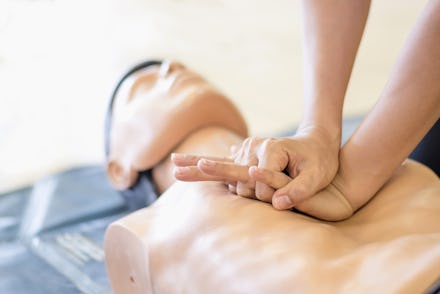CPR is only taught on male dummies. Changing that could save women's lives.

Like countless other things in our culture, the plastic dummies used to train medical professionals and others to perform cardiopulmonary resuscitation (CPR) are designed for men. Despite the fact that roughly half the population has breasts, mannequins are typically flat-chested, which means students don't learn proper hand placement and resuscitation techniques for female bodies. Yet a new breast attachment, Womanikin, aims to feminize mannequins so that CPR students can better assist women experiencing cardiac arrest.
The product, developed with the advocacy group United State of Women and ad agency JOAN Creative, is designed to be attached to the many CPR mannequins currently in use; by the end of 2020, Womaninkin aims to have the attachments used in every CPR training school in America.
That goal can't come soon enough. Heart disease is the leading killer of women in the United States, with one in five deaths of women attributed to heart health. Yet women are 6% less likely than men to be administered CPR in public while experiencing cardiac arrest, according to a 2017 study from University of Pennsylvania's Perelman School of Medicine. As noted in the study, that means that men’s chances of survival after a cardiac episode are 23 percent higher than those of women.
According to Nabil Abdulhay, the project coordinator for Penn’s Mobile CPR Unit, "there’s actually no difference" in the way you should perform CPR on a person based on their sex. He notes that when someone is in cardiac arrest, whether they have breasts or not doesn't matter; the heart is always in the same place, and the goal of CPR is to push directly on a failing heart in a fast, rhythmic way, to move blood to the brain.
Yet despite this truth, people hesitate to give CPR to women in public, which medical professionals believe has to due with fear more than anything else; people are scared of exposing a woman's breasts, hurting her, or causing a potential liability issue. And the lack of training on mannequins with breasts can add to this fear, as people aren't used to working with female bodies. These hesitations are not only unfounded, but dangerous, says Abdulhay. "All people need CPR," he explains. "We try and reiterate that if an individual is in cardiac arrest, they are clinically dead and by performing CPR, you’re dramatically increasing their chance of survival."
Enter: mannequin equality. As stated on its website, Womanikin aims to make CPR practitioners more confident and comfortable treating women in distress who require aid. "Since survival from cardiac arrest depends on the prompt delivery of CPR by a bystander, we need to think of ways to make CPR training more accessible to everyone and for everyone," Audrey L. Blewer, epidemiologist and resuscitation scientist at the Duke University School of Medicine Department of Family Medicine and Community Health, told Campaign Live. "We also need to consider ways to raise awareness around sudden cardiac arrest, address these known gender disparities, and empower more people to perform CPR if needed."
As Abdulhay says, fear shouldn't hold someone back from providing CPR; giving a person a few broken ribs or exposing their body isn't ideal, but if it saves their life, they'll undoubtedly be glad you helped. "Study after study shows that if a bystander performs CPR prior to an ambulance arrival, it dramatically increases chance of survival," says Abdulhay. "It's a very effective intervention to cardiac arrest."
He adds that he's glad that female bodies will finally be recognized on CPR training equipment to help normalize treatment for all people — especially since although women receive CPR less than men, "the majority of people who we train and who request our free CPR training are women," says Abdulhay. Women want to save each other's lives; now, they'll have better training to do so.